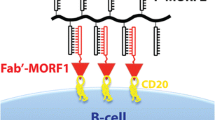Abstract
Uptake and biochemical and biological effects of antisense oligodeoxynucleotides (ODN) specific for c-abl and bcr genes were studied in normal immature myeloid cells. CD34-positive cells were purified by positive and negative selection and cultured in liquid culture for 7 days. These cells were then incubated with ODNs, either alone or in combination with cationic lipids. The uptake of ODNs was enhanced by the use of cationic lipids. In addition, very low concentrations of ODNs in combination with cationic lipids were capable of specifically inhibiting the expression of the c-abl gene. In contrast, no effects were seen on the expression of bcr. However, despite the effective blocking of c-abl expression, no changes in cellular growth patterns were observed in liquid culture or in a colony-forming assay. We conclude that the use of cationic lipids might enhance the gene-regulatory effects of ODNs by increasing their uptake into normal hematopoietic cells.
Similar content being viewed by others
References
Ben-Neriah Y, Daley GQ, Mes-Masson AM, Witte ON, Baltimore D (1986) The chronic myelogenous leukemia specific p210 protein is the product of the bcr-abl hybrid gene. Science 233:212–215
Benett CF, Chiang MY, Chan H, Shoemaker JEE, Mirabelli CK (1992) Cationic lipids enhance cellular uptake and activity of phosphorothioate antisense oligonucleotides. Mol Pharmacol 41:1023–1033
Bergan R, Connell Y, Fahmy B, Kyle E, Neckers L (1994) Aptameric inhibition of p210bcr-abl tyrosine kinase autophosphorylation by oligodeoxynucleotides of defined sequence and backbone structure. Nucleic Acids Res 22:2150–2154
Capaccioli S, Di Pasquale G, Mini E, Mazzei T, Quattrone A (1993) Cationic lipids improve antisense oligonucleotide uptake and prevent degradation in cultured cells and in human serum. Biochem Biophys Res Commun 197:818–825
Caracciolo D, Valtieri M, Venturelli D, Peschle C, Gewirtz AM, Calabretta B (1989) Lineage-specific requirement of cabl function in normal hematopoiesis. Science 245:1107–1110
Chin DJ, Green GA, Zon G, Skoza JR, Staubinger RM (1990) Rapid nuclear accumulation of injected oligonucleotides. New Biologist 2:1091–100
Chromczynski P, Sacci N (1987) Single step method of RNA isolation by acid-guanidinium-thiocyanate-phenol-chloroform extraction. Anal Biochem 162:156–164
Geselowitz DA, Neckers LM (1992) Analysis of oligonucleotide binding, internalization, and intracellular trafficking utilizing a novel radiolabeled cross-linker. Antisense Res Dev 2:17–25
Giles RV, Tidd DM (1992) Increased specificity for antisense oligodeoxynucleotide targeting of RNA-cleavage by RNAse H using chimeric methypphosphonate/phosphodiester structures. Nucleic Acids Res 20:763–770
Helene C, Toulme JJ (1990) Specific regulation of gene expression by antisense, sense and antigene nucleic acids. Biochim Biophys Acta 1049:99–125
Keller G, Kennedy M, Papayannopoulou T, Wiles MV (1993) Hematopoietic commitment during embryonic stem cell differentiation in culture. Mol Cell Biol 13:473–86
Leonetti JP, Mechti N, Degols G, Gagnor C, Lebleu B (1991) Intracellular distribution of microinjected oligonucleotides. Proc Natl Acad Sci USA 88:2702–2706
Liberati AM, Donti E, Rosso C, Lo Coco F, Dore F, Pardini S, Cocco S, Addis M, Saglio G (1994) Repeated PCR in CML during IFN-alpha therapy. Eur J Haematol 52:152–155
Mc Laughlin LW, Piel N 1984) Oligonucleotide synthesis. A practical approach. In: Gait MJ (ed) Chromatographic purification of synthetic oligonucleotides. IRL Press, Oxford, pp 117–133
Nowell PC, Hungerford DA (1960) A minute chromosome in human granulocytic leukemia. Science 132:1497–1500
Saiki RK, Gelfand DH, Stoffel S, Scharf SJ, Higuchi R, Horn GT, Mullis KB, Erlich HA (1988) Primer-directed enzymatic amplification of DNA with a thermostable DNA polymerase. Science 239:487–490
Spiller DG, Tidd DM (1992) The uptake of chimeric oligonucleotide analogues in human leukemia MOLT-4 cells. Anticancer Drug Des 7:115–119
Thierry AR, Dritschilo A (1992) Intracellular availability of unmodified, phosphorothioated and liposomally encapsulated oligodeoxynucleotides for antisense activity. Nucleic Acids Res 20:5691–5698
Woolf TM, Jennings CG, Rebagliati M, Melton DA (1990) The stability and toxicity and effectiveness of unmodified and phosphorothioate antisense oligodeoxynucleotides inXenopus oocytes and embryos. Nucleic Acids Res 18:1763–9
Zhao Q, Matson S, Herrera CJ, Fisher E, Yu H, Krieg AM (1993) Comparison of cellular binding and uptake of antisense phosphodiester, phosphorothioate, and mixed phosphorothioate and methyphosphonate oligonucleotides. Antisense Res Dev 3:53–66
Author information
Authors and Affiliations
Additional information
This work was funded by a research grant from theGesellschaft für Biologische Krebsabwehr.
Rights and permissions
About this article
Cite this article
Albrecht, T., Schwab, R., Peschel, C. et al. Cationic lipide mediated transfer of c-abl and bcr antisense oligonucleotides to immature normal myeloid cells: Uptake, biological effects and modulation of gene expression. Ann Hematol 72, 73–79 (1996). https://doi.org/10.1007/BF00641311
Received:
Accepted:
Issue Date:
DOI: https://doi.org/10.1007/BF00641311




